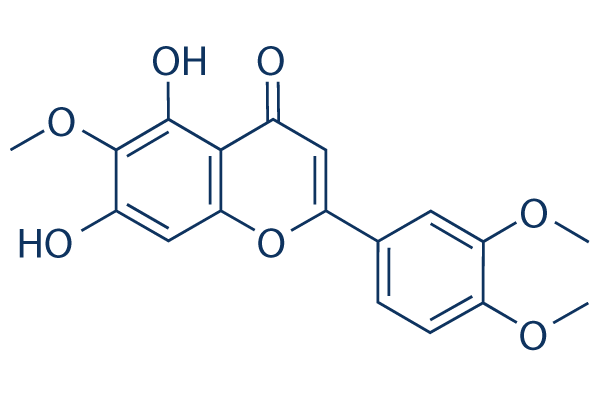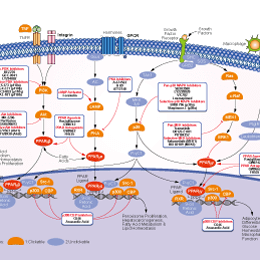
- Bioactive Compounds
- By Signaling Pathways
- PI3K/Akt/mTOR
- Epigenetics
- Methylation
- Immunology & Inflammation
- Protein Tyrosine Kinase
- Angiogenesis
- Apoptosis
- Autophagy
- ER stress & UPR
- JAK/STAT
- MAPK
- Cytoskeletal Signaling
- Cell Cycle
- TGF-beta/Smad
- Compound Libraries
- Popular Compound Libraries
- Customize Library
- Clinical and FDA-approved Related
- Bioactive Compound Libraries
- Inhibitor Related
- Natural Product Related
- Metabolism Related
- Cell Death Related
- By Signaling Pathway
- By Disease
- Anti-infection and Antiviral Related
- Neuronal and Immunology Related
- Fragment and Covalent Related
- FDA-approved Drug Library
- FDA-approved & Passed Phase I Drug Library
- Preclinical/Clinical Compound Library
- Bioactive Compound Library-I
- Bioactive Compound Library-Ⅱ
- Kinase Inhibitor Library
- Express-Pick Library
- Natural Product Library
- Human Endogenous Metabolite Compound Library
- Alkaloid Compound LibraryNew
- Angiogenesis Related compound Library
- Anti-Aging Compound Library
- Anti-alzheimer Disease Compound Library
- Antibiotics compound Library
- Anti-cancer Compound Library
- Anti-cancer Compound Library-Ⅱ
- Anti-cancer Metabolism Compound Library
- Anti-Cardiovascular Disease Compound Library
- Anti-diabetic Compound Library
- Anti-infection Compound Library
- Antioxidant Compound Library
- Anti-parasitic Compound Library
- Antiviral Compound Library
- Apoptosis Compound Library
- Autophagy Compound Library
- Calcium Channel Blocker LibraryNew
- Cambridge Cancer Compound Library
- Carbohydrate Metabolism Compound LibraryNew
- Cell Cycle compound library
- CNS-Penetrant Compound Library
- Covalent Inhibitor Library
- Cytokine Inhibitor LibraryNew
- Cytoskeletal Signaling Pathway Compound Library
- DNA Damage/DNA Repair compound Library
- Drug-like Compound Library
- Endoplasmic Reticulum Stress Compound Library
- Epigenetics Compound Library
- Exosome Secretion Related Compound LibraryNew
- FDA-approved Anticancer Drug LibraryNew
- Ferroptosis Compound Library
- Flavonoid Compound Library
- Fragment Library
- Glutamine Metabolism Compound Library
- Glycolysis Compound Library
- GPCR Compound Library
- Gut Microbial Metabolite Library
- HIF-1 Signaling Pathway Compound Library
- Highly Selective Inhibitor Library
- Histone modification compound library
- HTS Library for Drug Discovery
- Human Hormone Related Compound LibraryNew
- Human Transcription Factor Compound LibraryNew
- Immunology/Inflammation Compound Library
- Inhibitor Library
- Ion Channel Ligand Library
- JAK/STAT compound library
- Lipid Metabolism Compound LibraryNew
- Macrocyclic Compound Library
- MAPK Inhibitor Library
- Medicine Food Homology Compound Library
- Metabolism Compound Library
- Methylation Compound Library
- Mouse Metabolite Compound LibraryNew
- Natural Organic Compound Library
- Neuronal Signaling Compound Library
- NF-κB Signaling Compound Library
- Nucleoside Analogue Library
- Obesity Compound Library
- Oxidative Stress Compound LibraryNew
- Plant Extract Library
- Phenotypic Screening Library
- PI3K/Akt Inhibitor Library
- Protease Inhibitor Library
- Protein-protein Interaction Inhibitor Library
- Pyroptosis Compound Library
- Small Molecule Immuno-Oncology Compound Library
- Mitochondria-Targeted Compound LibraryNew
- Stem Cell Differentiation Compound LibraryNew
- Stem Cell Signaling Compound Library
- Natural Phenol Compound LibraryNew
- Natural Terpenoid Compound LibraryNew
- TGF-beta/Smad compound library
- Traditional Chinese Medicine Library
- Tyrosine Kinase Inhibitor Library
- Ubiquitination Compound Library
-
Cherry Picking
You can personalize your library with chemicals from within Selleck's inventory. Build the right library for your research endeavors by choosing from compounds in all of our available libraries.
Please contact us at [email protected] to customize your library.
You could select:
- Antibodies
- Bioreagents
- qPCR
- 2x SYBR Green qPCR Master Mix
- 2x SYBR Green qPCR Master Mix(Low ROX)
- 2x SYBR Green qPCR Master Mix(High ROX)
- Protein Assay
- Protein A/G Magnetic Beads for IP
- Anti-Flag magnetic beads
- Anti-Flag Affinity Gel
- Anti-Myc magnetic beads
- Anti-HA magnetic beads
- Poly FLAG Peptide lyophilized powder
- Protease Inhibitor Cocktail
- Protease Inhibitor Cocktail (EDTA-Free, 100X in DMSO)
- Phosphatase Inhibitor Cocktail (2 Tubes, 100X)
- Cell Biology
- Cell Counting Kit-8 (CCK-8)
- Animal Experiment
- Mouse Direct PCR Kit (For Genotyping)
- New Products
- Contact Us
Eupatilin
Synonyms: NSC 122413
Eupatilin (NSC 122413), a major flavonoid from Artemisia plants, possesses various beneficial biological effects including anti-inflammation, anti-tumor, anti-cancer, anti-allergy, and anti-oxidation activity. Eupatilin, a lipophilic flavonoid isolated from Artemisia species, is a PPARα agonist, and possesses anti-apoptotic, anti-oxidative and anti-inflammatory activities.

Eupatilin Chemical Structure
CAS: 22368-21-4
Selleck's Eupatilin has been cited by 4 publications
Purity & Quality Control
Batch:
Purity:
99.45%
99.45
Eupatilin Related Products
| Related Targets | PPARα PPARβ/δ PPARγ PPARδ | Click to Expand |
|---|---|---|
| Related Compound Libraries | Metabolism Compound Library Anti-cancer Metabolism Compound Library Glutamine Metabolism Compound Library Carbohydrate Metabolism Compound Library Lipid Metabolism Compound Library | Click to Expand |
Signaling Pathway
Choose Selective PPAR Inhibitors
Biological Activity
| Description | Eupatilin (NSC 122413), a major flavonoid from Artemisia plants, possesses various beneficial biological effects including anti-inflammation, anti-tumor, anti-cancer, anti-allergy, and anti-oxidation activity. Eupatilin, a lipophilic flavonoid isolated from Artemisia species, is a PPARα agonist, and possesses anti-apoptotic, anti-oxidative and anti-inflammatory activities. |
|---|
| In vitro | ||||
| In vitro | Eupatilin has been reported to induce apoptosis in human gastric cancer AGS cells, also triggers differentiation of these cells. Treatment of AGS cells with eupatilin induces cell cycle arrest at the G1 phase with the concomitant induction of p21cip1, a cell cycle inhibitor. It also markedly induces trefoil factor1(TFF1). Eupatilin dramatically induces redistribution of tight junction proteins such as occludin and ZO-1, and F-actin at the junctional region between cells. It also induces phosphorylation of extracellular signal-regulated kinase 2 and p38 kinase. Eupatilin is known to inhibit the growth of MCF-10A-ras cells by inhibiting the expression of cell cycle regulators such as cyclinD1, cyclinB1, Cdk2, and Cdc2[1]. | |||
|---|---|---|---|---|
| Cell Research | Cell lines | Human gastric epithelial AGS cells | ||
| Concentrations | 10-500 μM | |||
| Incubation Time | 24, 48, 72 h | |||
| Method | Cellular viability is determined by PI incorporation. Cells are treated with various reagents, washed with PBS twice, resuspended in PBS containing 20 μg/ml PI, and then immediately analyzed on a FACSCalibur. PI-positive cells are counted as dead cells and the remaining cells are designated as viable cells. | |||
| In Vivo | ||
| In vivo | Treatment with eupatilin significantly decreases serum alanine aminotransferase and serum aspartate aminotransferase as well as liver histologic changes. Eupatilin also preventes hepatic glutathione depletion and increases malondialdehyde levels induced by Ischemia-reperfusion injury (IRI). It improves the acute hepatic IRI by reducing inflammation and apoptosis[2]. Oral administration of eupatilin (10 mg/kg) in a therapeutic paradigm significantly reduces brain infarction and improves neurological functions in tMCAO-challenged mice. Eupatilin administration reduces the number of Iba1-immunopositive cells across ischemic brain and induces their morphological changes from amoeboid into ramified in the ischemic core, which is accompanied with reduced microglial proliferation in ischemic brain. Eupatilin suppresses NF-κB signaling activities in ischemic brain by reducing IKKα/β phosphorylation, IκBα phosphorylation, and IκBα degradation[3]. | |
|---|---|---|
| Animal Research | Animal Models | C57BL/6 mice |
| Dosages | 10 mg/kg | |
| Administration | oral | |
Chemical Information & Solubility
| Molecular Weight | 344.32 | Formula | C18H16O7 |
| CAS No. | 22368-21-4 | SDF | Download Eupatilin SDF |
| Smiles | COC1=C(C=C(C=C1)C2=CC(=O)C3=C(O2)C=C(C(=C3O)OC)O)OC | ||
| Storage (From the date of receipt) | |||
|
In vitro |
DMSO : 68 mg/mL ( (197.49 mM); Moisture-absorbing DMSO reduces solubility. Please use fresh DMSO.) |
Molecular Weight Calculator |
|
In vivo Add solvents to the product individually and in order. |
In vivo Formulation Calculator |
||||
Preparing Stock Solutions
Molarity Calculator
In vivo Formulation Calculator (Clear solution)
Step 1: Enter information below (Recommended: An additional animal making an allowance for loss during the experiment)
mg/kg
g
μL
Step 2: Enter the in vivo formulation (This is only the calculator, not formulation. Please contact us first if there is no in vivo formulation at the solubility Section.)
% DMSO
%
% Tween 80
% ddH2O
%DMSO
%
Calculation results:
Working concentration: mg/ml;
Method for preparing DMSO master liquid: mg drug pre-dissolved in μL DMSO ( Master liquid concentration mg/mL, Please contact us first if the concentration exceeds the DMSO solubility of the batch of drug. )
Method for preparing in vivo formulation: Take μL DMSO master liquid, next addμL PEG300, mix and clarify, next addμL Tween 80, mix and clarify, next add μL ddH2O, mix and clarify.
Method for preparing in vivo formulation: Take μL DMSO master liquid, next add μL Corn oil, mix and clarify.
Note: 1. Please make sure the liquid is clear before adding the next solvent.
2. Be sure to add the solvent(s) in order. You must ensure that the solution obtained, in the previous addition, is a clear solution before proceeding to add the next solvent. Physical methods such
as vortex, ultrasound or hot water bath can be used to aid dissolving.
Tech Support
Answers to questions you may have can be found in the inhibitor handling instructions. Topics include how to prepare stock solutions, how to store inhibitors, and issues that need special attention for cell-based assays and animal experiments.
Tel: +1-832-582-8158 Ext:3
If you have any other enquiries, please leave a message.
* Indicates a Required Field
Tags: buy Eupatilin | Eupatilin supplier | purchase Eupatilin | Eupatilin cost | Eupatilin manufacturer | order Eupatilin | Eupatilin distributor








































